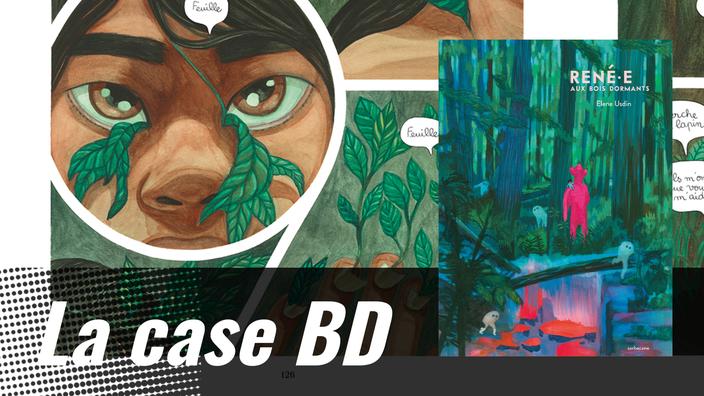René lives on the tenth floor of a building, in the folds of
"a giant's pocket square"
.
When the storm rumbles,
"it rains germs from its nose"
.
René has a lot of imagination.
When he takes the bus, the insults of the other children are heard.
Is it because her eyes and hair are different?
One evening, his mother gives him an empty box of a refrigerator;
the boy shelters there with his rabbit, Sucre Doux.
When he wakes up, the blanket has disappeared.
Then begins a great adventure beyond dreams, on the other side of the mirror.
Who is he really?
Where is he from?
Read also
Grand Silence,
when the tale breaks the taboo of incest
Published on September 1, 2021 by Sarbacane editions,
René · e aux bois dormants
is the first comic strip by Elene Usdin, until then an illustrator and photographer.
Graphically breathtaking, this 272-page novel - done in watercolor and gouache, sometimes enhanced with pencil - tells the phantasmagorical odyssey of René, a little Aboriginal boy from Canada in search of his roots.
René · e aux bois dormants
tells the story of the quest for identity of a little native boy torn from his family.
Elene Usdin / Mailify
Raised by a white adoptive mother, he forgot about his family and his people. A direct reference to the “Sixties Scoop”, a brutal attempt to assimilate 20,000 indigenous children torn from their homes. A black page in Canadian history that the author discovered in 2017 during a trip to North America:
“I was absolutely unaware. It upset me, it hurt me. ”
She then decides to integrate this issue into her comic book project which was until then rather
"a kind of ecological tale".
“Depriving the Aorens of memory was a way of making them innocent, close to the carefree youth, but also of attaching them to the present moment without worrying about the past or the future,”
explains Elene Usdin. Elene Usdin / Mailify
However, nature retains an essential place in this story, which pays tribute to the culture of native Canadians and their harmonious relationship with the land. Less well-known, their very fluid conception of gender identities is reflected in the character of René · e,
a two-minded
man and woman at the same time (hence the inclusive writing).
“The Amerindians dress in a neutral way their children who have not yet chosen their gender,
explains Elene Usdin to
Figaro
.
This choice mainly determines the role that we will have in society: rather a hunter or rather in the village to work the fabric, for example. ”
Throughout his dreamlike journey and his metamorphoses, René · e lives or is told multiple stories that we imagine all inspired by indigenous folklore ... which is not at all the case! The fertile imagination of the artist, used to illustrating mythologies from around the world (Tibetan, Russian, Mediterranean ...) does the rest. Among the invented tales, one features the first Aoren who,
"unable to remember beyond a few moments",
falls in love with the same girl every day, in
"a continual epiphany".
Gorgeous!
“I dreamed of doors that I was pushing. In all the bedrooms, there were lots of mattresses stacked up and no one slept on them… I wondered: where are the people? ”
, explains the artist when asked about the recurrence of mattresses in his works. Elene Usdin / Sarbacace
Elene Usdin's inspiration comes first from her own dreamlike wanderings.
"I have always had a fairly strong relationship with my dreams, which are very precise and which I note in my notebooks," she
says, referring to
"a parallel world that we visit every night",
shared with
everyone.
humanity within the framework of a great collective unconscious.
She does not try to explain her dreams and prefers to take them
"as a proper language".
Do not shamans use him to dialogue with natural forces?
"Literary texts make me travel super far and give birth to images in my head"
Elene usdin
Certain artists inspire Elene Usdin, in particular the jack-of-all-trades Alejandro Jodorowsky, whose poems she particularly likes.
“Literary texts make me travel super far and create images in my head,”
says the one who is also an admirer of Native American authors Richard Wagamese and Joy Harjo. As for visual references, she cites Hayao Miyazaki
"and all the strength of his female characters"
, Francis Bacon, Peter Doig, Félix Vallotton for
"his relationship to lights, to colors"
, Paul Gauguin and
"his bloodthirsty side"
, David Lynch, Federico Fellini, Bertrand Mandico… Her interest in cinema led her to make paintings visible on the screen in
Pola X
by Leos Carax and
Portrait of the young girl on fire
by Céline Sciamma. From her period as a photographer, she kept a Picto Fashion Award in 2006 and a
“desire for staging”
that can be found in her series of handmade woolen masks and, of course, her first graphic novel.
Produced between September 2020 and July 2020, in record time,
René e aux bois dormants
put the artist's nerves to the test, who forced himself to meet these impossible deadlines.
“I have found myself for the past four months having to cut up to four boards a day.
I worked twenty hours a day, it was horrible! ”She
laughs today.
A first experience which will not however distract her from the ninth Art.
A new project is already underway ...
BD box
Renée's transformation into a tree is inspired by a poem by Francis Ponge,
The Cycle of Seasons.
Elene Usdin / Mailify
At this late stage in the story, Renée, now female, gradually turns into a tree, under the scrutiny of Mother Bird.
"This idea came to me from a dream and from
a poem by Francis Ponge,
The Cycle of the Seasons,
where he describes the point of view of a tree which, astonished by the spring, sees its leaves open and grow. feels taken with an enormous pride ”,
tells Elene Usdin, before admitting that this type of transformation, already lived by Daphne at Ovid, is clearly part of our collective unconscious.
The gigantic Mother Bird, on the other hand, represents the ambivalence of the forces of nature, both frightening and grandiose.
“We imagine birds as harmless beings but, when you think about it, they have prehistoric roots and can be monstrous!
considers the author.
Here, this high priestess collects humans lost in cities to transform them into trees and repopulate her forest. ”
Renée does not seem particularly worried about this
"renewal of energies in the balance of our environment".
Its transformation also seems very gentle: fingernails that lift delicately, branches and leaves that pierce painlessly ... We are far from the heartbreaks that the "body horror" cinema loves:
"However, I am super attracted by
metamorphoses as in
Titanium
! "
,
says Elene Usdin.
"It is a very animistic vision of things: the one we have in front of it is an" other "entity which could be an inverted mirror of itself"
Elene usdin
The whole album was designed on a double page spread and this one is no exception, with a skilful almost symmetrical cutting. A work that results from a complex process: adhesive tape is first placed on the pages to reserve the future white of the gutters. She then applies a slightly liquid gouache wash - an
“emerald green solid
color
”
in the case of the forest -, lets dry, then paints the characters and the decorations in watercolors.
“It gives a hue, a chromatic range to the whole, even when I apply a red or a skin,
details Elene Usdin.
The bird on the right page has a greenish tint, like the whites of Renée's eyes. With the gouache underneath, it's as if I were working on a limestone wall, it's porous! ”
In addition to the aesthetic balance of the composition, the play of looks between Renée and Mère Oiseau reinforces the contrast between the two characters, as does the low angle to the right.
The reflection of the girl in the eye of the animal is not insignificant either:
"It is a very animist vision of things: the one we have in front of it is an 'other' entity that could to be an inverted mirror of oneself ”,
deciphers the artist.
Each box is thought of as a small autonomous painting while communicating via effects of continuity, extending the locks of hair beyond the gutters.
"Cutting the hair is a hyperviolent gesture that was made to Amerindian children when they arrived in residential schools, whereas for them it is a vital force"
Elene usdin
René · e's beautiful face was designed after “
a mix between archival photos of Native Americans. The associations of survivors of the Sixties Scoop post pictures of them as children, ”
says the author. The character's hair regrowth, which has it short at the beginning of the book, is also loaded with meaning:
"Cutting the hair is a hyperviolent gesture that was made to Amerindian children when they arrived in boarding schools, so that for them it is a vital force,
explains the artist. Before concluding: "
Much closer to me, I got attached to drawing René's bowl cut like in the photos of my cousin whose hair I adored and with whom I was quite close.
I learned later, as a teenager, that his mother was not his biological mother… Unconsciously that must have played out. ”
René · e aux bois dormants,
by Elene Usdin, Sarbacane, 272 pages, 32 euros.













